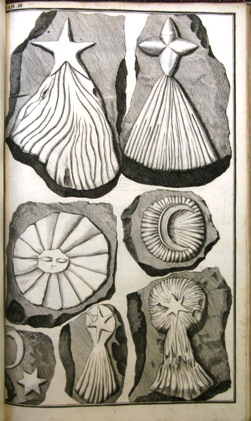
Academic rivals conspire to bring down their hated colleague with a hoax that got out of hand…
Geoscientist 21.11 December 2011/January 2012
If asked to name a famous geological hoax, the most likely response from readers would surely be that of the Piltdown Man, the ‘missing link’ which was reported almost one hundred years ago at the Society, on 18 December 1912. Perhaps less well known is a much more elaborate (though more comical) ruse that took place in Germany 200 years earlier – the ‘Lying Stones’ of Dr Johann Bartholomew Adam Beringer (1667 – 1740).
Beringer, Dean of the Faculty of Medicine at the University of Würzburg, was a keen collector of fossils. In May 1725, when he paid three local youths to explore nearby Mount Eivelstadt, they returned with the most remarkable items: representations in stone of fishes and frogs, insects and crabs, sea-shells and land plants, as well as, wrote Beringer: “clear images of the sun and the moon, of stars, and of comets radiant with flaming tail”.
With smiling faces and cartoonish shapes it is immediately obvious to modern eyes that the stones were carved by humans; but Beringer was convinced they were the work of nature, arguing that there were too many for a hoaxer to have produced them all. He began to record the findings in Lithographiae Wirceburgensis, where he presents various theories as to their creation. Just as the first copies of the book were being printed, however, Beringer was presented with a final stone - with his own name carved in it!
For years the tale was retold as one of the University Dean being humiliated by wily local boys; but in 1963 historians Melvin E Jahn and Daniel J Woolf revealed that the hoax was a plot by two of Beringer’s jealous colleagues, J Ignatz Roderick and Georg von Eckhart. Both were successfully prosecuted and disgraced for their actions.
The story does have another happy ending. When he realised the extent of the hoax Beringer frantically bought as many copies of the book as he could and presumably destroyed them. This means copies of Lithographiae Wirceburgensis are extremely rare, making this strange relic in the Society’s collection a very valuable item indeed!
For a fuller account of this history see Edmonds, J & Powell, H 1974 Beringer ‘Lugensteine’ at Oxford Proc. Geol. Ass. 85: 549 – 553, or www.archaeology.org/online/features/hoaxes/beringer.html
- The Library operates a sponsorship scheme to help preserve and restore its rare books. For more information, contact Michael McKimm in the library, or go to: Sponsor-a-Book